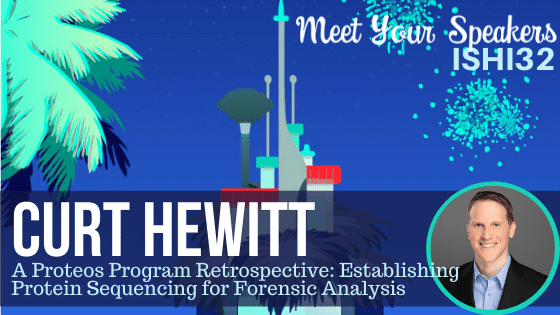For the past three years, Signature Science has been working on the IARPA PROTEOS program to demonstrate that protein sequencing can successfully be used for human forensic identification for samples where DNA was either absent or degraded, specifically touch samples. Together with the University of North Texas Health Science Center and The Ohio State University, they have established novel sample preparation methods, analytical pipelines, and statistical frameworks to support future implementation in forensic labs.
In his presentation at ISHI 32, Curt Hewitt will demonstrate the utility of proteomic analysis with both internally generated and blinded, third-party provided touch samples. These include samples placed on brass shell casings, wood, metal, glass, and environmentally degraded porous and non-porous surfaces.
We caught up with Curt to discuss when it’s advantageous to use protein sequencing rather than DNA analysis, the workflow, and the equipment needed.
In what cases is it advantageous to use protein sequencing rather than DNA analysis?
Protein sequencing is most useful for samples that frequently fail to yield sufficient DNA for analysis. In our case, our focus has been touch samples. Others have focused on matrices like hair or bone. That said, we’ve found that protein can provide additional value for mixture analysis of touch samples even when DNA is present, sometimes identifying contributors within a sample that would otherwise have been missed.
Without giving too much away, can you share a bit about the workflow that you’ll be presenting at ISHI? Can this workflow be implemented in other forensic laboratories?
We have created a workflow that allows protein within a touch sample to be recovered from a typical DNA purification process with almost no modifications from conventional forensic analysis lab practices. This is key, because it does not require forensic labs to sacrifice potential DNA yield from a sample in order to analyze protein sequence. Our workflow then proceeds through protein sequence analysis to identify a panel of protein polymorphisms that are then used to calculate forensic match statistics.
What equipment/tools are necessary for implementing this workflow in a lab?
For sample preparation, labs currently working with DNA should have everything they need. For protein analysis, labs would require a high-resolution accurate mass liquid chromatography–mass spectrometry system. This is not a common instrument in most forensic labs, so it may be necessary to find collaborators with this capability.
What tips would you give to someone who is just starting out in the field of forensics, or what is the best advice that you’ve received?
I’m on the R&D side of things, so the most important advice I can give is to be creative in how you approach problems and constantly check your assumptions against the data.
Has there been anything good that came out of the pandemic that you’ll continue doing going forward?
I think I will better appreciate not being in a pandemic once the pandemic is over!
What is your favorite Disney character and why, or which Disney character do you most relate to and why?
Probably Wall-E. I feel like we are equally amazed by and oblivious to much of the world around us.
If you could have one superpower, what would it be and why?
Time travel. Barring any universe ending paradoxes, when wouldn’t that be useful?
What’s one thing that others may not know about you?
I grew up racing go karts and I’m entirely comfortable going 90 mph three quarters of an inch above the ground.
WOULD YOU LIKE TO SEE MORE ARTICLES LIKE THIS? SUBSCRIBE TO THE ISHI BLOG BELOW!
SUBSCRIBE NOW!


